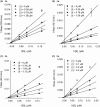Design, synthesis, and evaluation of curcumin analogues as potential inhibitors of bacterial sialidase
- PMID: 30126306
- PMCID: PMC6104608
- DOI: 10.1080/14756366.2018.1488695
Design, synthesis, and evaluation of curcumin analogues as potential inhibitors of bacterial sialidase
Abstract
Sialidases are key virulence factors that remove sialic acid from the host cell surface glycan, unmasking receptors that facilitate bacterial adherence and colonisation. In this study, we developed potential agents for treating bacterial infections caused by Streptococcus pneumoniae Nan A that inhibit bacterial sialidase using Turmeric and curcumin analogues. Design, synthesis, and structure analysis relationship (SAR) studies have been also described. Evaluation of the synthesised derivatives demonstrated that compound 5e was the most potent inhibitor of S. pneumoniae sialidase (IC50 = 0.2 ± 0.1 µM). This compound exhibited a 3.0-fold improvement in inhibitory activity over that of curcumin and displayed competitive inhibition. These results warrant further studies confirming the antipneumococcal activity 5e and indicated that curcumin derivatives could be potentially used to treat sepsis by bacterial infections.
Keywords: Curcumin; Nan A; sepsis; sialidase.
Figures





Similar articles
-
Sialidase inhibitory activity of diarylnonanoid and neolignan compounds extracted from the seeds of Myristica fragrans.Bioorg Med Chem Lett. 2017 Jul 15;27(14):3060-3064. doi: 10.1016/j.bmcl.2017.05.055. Epub 2017 May 18. Bioorg Med Chem Lett. 2017. PMID: 28551100
-
Streptococcus pneumoniae Sialidase SpNanB-Catalyzed One-Pot Multienzyme (OPME) Synthesis of 2,7-Anhydro-Sialic Acids as Selective Sialidase Inhibitors.J Org Chem. 2018 Sep 21;83(18):10798-10804. doi: 10.1021/acs.joc.8b01519. Epub 2018 Aug 23. J Org Chem. 2018. PMID: 30105908 Free PMC article.
-
Screening assay for inhibitors of a recombinant Streptococcus pneumoniae UDP-glucose pyrophosphorylase.J Enzyme Inhib Med Chem. 2017 Dec;32(1):203-207. doi: 10.1080/14756366.2016.1247055. J Enzyme Inhib Med Chem. 2017. PMID: 28114831 Free PMC article.
-
Recent Advances in the Development of Undecaprenyl Pyrophosphate Synthase Inhibitors as Potential Antibacterials.Curr Med Chem. 2016;23(5):464-82. doi: 10.2174/0929867323666151231094854. Curr Med Chem. 2016. PMID: 26718796 Review.
-
Heterocyclic Curcumin Derivatives of Pharmacological Interest: Recent Progress.Curr Top Med Chem. 2015;15(17):1663-72. doi: 10.2174/1568026615666150427111837. Curr Top Med Chem. 2015. PMID: 25915614 Review.
Cited by
-
Improved Synthesis of Asymmetric Curcuminoids and Their Assessment as Antioxidants.Molecules. 2022 Apr 14;27(8):2547. doi: 10.3390/molecules27082547. Molecules. 2022. PMID: 35458741 Free PMC article.
-
Sialidase Inhibitors with Different Mechanisms.J Med Chem. 2022 Oct 27;65(20):13574-13593. doi: 10.1021/acs.jmedchem.2c01258. Epub 2022 Oct 17. J Med Chem. 2022. PMID: 36252951 Free PMC article. Review.
-
An In Vitro and In Silico Study of Antioxidant Properties of Curcuminoid N-alkylpyridinium Salts: Initial Assessment of Their Antitumoral Properties.Antioxidants (Basel). 2022 Jun 1;11(6):1104. doi: 10.3390/antiox11061104. Antioxidants (Basel). 2022. PMID: 35740001 Free PMC article.
-
Sialidases From Clostridium perfringens and Their Inhibitors.Front Cell Infect Microbiol. 2020 Jan 10;9:462. doi: 10.3389/fcimb.2019.00462. eCollection 2019. Front Cell Infect Microbiol. 2020. PMID: 31998664 Free PMC article. Review.
-
Recent advances in the discovery of plant-derived antimicrobial natural products to combat antimicrobial resistant pathogens: insights from 2018-2022.Nat Prod Rep. 2023 Jul 19;40(7):1271-1290. doi: 10.1039/d2np00090c. Nat Prod Rep. 2023. PMID: 37439502 Free PMC article. Review.
References
-
- O'Brien KL, Wolfson LJ, Watt JP, et al. Burden of disease caused by Streptococcus pneumoniae in children younger than 5 years: global estimates. Lancet 2009;374:893–902. - PubMed
-
- Bogaert D, De Groot R, Hermans PW. Streptococcus pneumoniae colonisation: the key to pneumococcal disease. Lancet Infect Dis 2004;4:144–54. - PubMed
MeSH terms
Substances
LinkOut - more resources
Full Text Sources
Other Literature Sources
Medical
Miscellaneous
